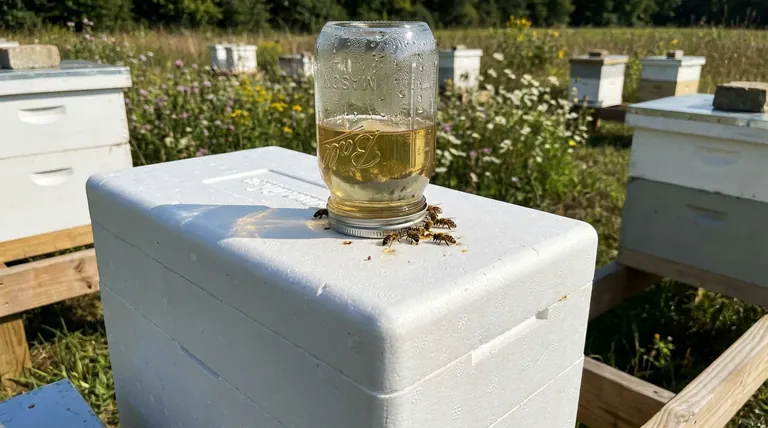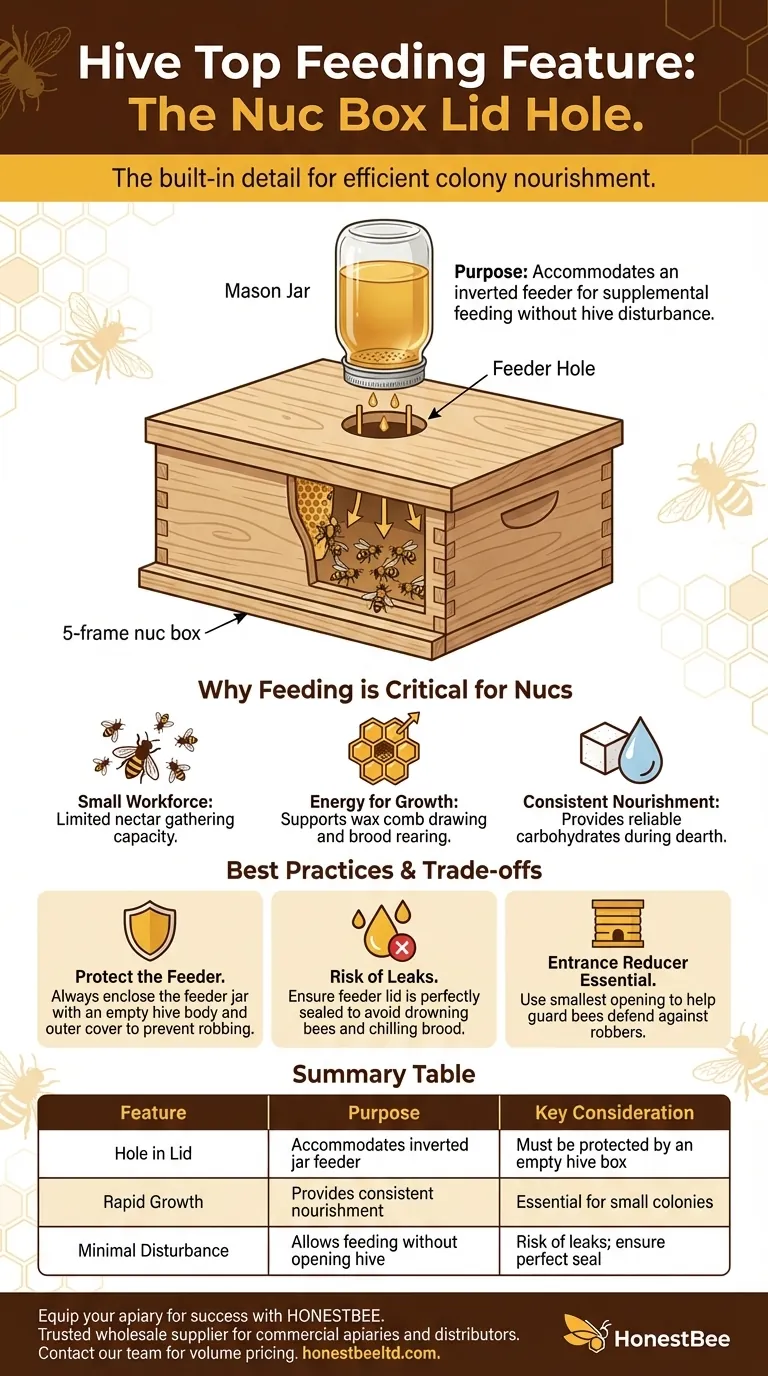Many 5-frame nuc box lids are designed with a specific purpose in mind. This built-in detail is almost always a feature for hive top feeding, typically a hole in the center of the inner cover or lid. This allows a beekeeper to provide nourishment to the colony efficiently and with minimal disturbance to the bees.
The hole in your nuc lid is not a defect—it is a deliberate feature for efficient feeding. Understanding how to use it correctly is essential for promoting rapid growth in a young colony while minimizing risks like drowning or robbing.

The Purpose of the Lid Feature: Hive Top Feeding
A nucleus colony, or "nuc," is a small starter hive. Its primary goal is to grow quickly into a full-sized, productive colony. This growth requires an immense amount of resources, which is where feeding comes in.
Why Feeding a Nuc is Critical
A small colony has a small workforce. It can struggle to gather enough nectar to both feed the existing bees and provide the energy needed to draw out wax comb and raise new brood, especially if there isn't a strong natural nectar flow.
Supplemental feeding with sugar water provides the colony with a reliable source of carbohydrates. This crucial support allows them to focus their energy on expansion.
How the Lid Feature Enables Feeding
The hole in the lid is designed to accommodate an inverted feeder, most commonly a simple Mason jar.
The beekeeper fills a jar with sugar syrup and replaces the flat lid with a cap that has several small, nail-sized holes punched in it. The jar is then quickly inverted and placed directly over the hole in the nuc lid.
Vacuum pressure keeps the syrup from pouring out, but the bees can access the feed from below by drinking it through the perforations. This method is far less disruptive than opening the entire hive to fill an internal feeder.
Understanding the Trade-offs and Best Practices
While this feature is designed for efficiency, using it correctly requires a few key considerations to ensure the colony's safety and well-being.
You Must Protect the Feeder
Simply placing a jar on top of the nuc exposes it to the elements and, more importantly, to robber bees from other hives.
To use this feature correctly, you must place an empty hive box (either a nuc-sized or 10-frame box) over the nuc lid, enclosing the feeder jar. An outer cover is then placed on top of that empty box. This setup protects the feeder and prevents robbing.
The Risk of Leaks
The biggest pitfall of this feeding method is the potential for leaks. If the feeder jar's lid is not sealed perfectly or if temperature fluctuations break the vacuum seal, syrup can drip or pour into the hive.
A significant leak can chill the brood and drown a large number of bees, which is devastating for a small nuc. Always check that your feeder lid is on tight and does not leak before placing it on the hive.
Entrance Reducers are Essential
When you are feeding any colony, especially a small one, you make it a target for stronger hives in the area. Always use an entrance reducer set to its smallest opening to help the nuc's guard bees defend their home from robbers.
Making the Right Choice for Your Goal
Using the built-in feeder hole is a tactical decision based on the colony's needs and the environmental conditions.
- If your primary focus is rapid colony growth: Use the hive top feeder feature to provide consistent nourishment, especially during a nectar dearth or when establishing a new package or nuc.
- If your primary focus is minimizing hive disturbance: This method is ideal, as it allows you to refill feed without breaking the propolis seal and inspecting the frames.
- If your primary focus is preventing robbing and leaks: Always ensure your feeder jar is properly sealed and completely enclosed by an empty hive body and outer cover.
Mastering simple equipment features like this is a fundamental step toward becoming a more observant and effective beekeeper.
Summary Table:
| Feature | Purpose | Key Consideration |
|---|---|---|
| Hole in Lid | Accommodates an inverted jar feeder for sugar syrup. | Must be protected by an empty hive box to prevent robbing. |
| Rapid Growth | Provides consistent nourishment during a nectar dearth. | Essential for small colonies with a limited workforce. |
| Minimal Disturbance | Allows feeding without opening the hive. | Risk of leaks; ensure feeder lid is sealed perfectly. |
Equip your apiary for success with HONESTBEE.
As a trusted wholesale supplier for commercial apiaries and beekeeping equipment distributors, we understand that efficient tools are the foundation of a thriving operation. The built-in feeder detail on a nuc box is just one example of how the right equipment supports healthy, productive colonies.
HONESTBEE supplies the durable, purpose-built beekeeping supplies and equipment you need to manage your hives effectively and scale your business. Let us help you build a stronger operation.
Contact our wholesale team today to discuss your equipment needs and volume pricing.
Visual Guide

Related Products
- Portable Bee Mating Hive Boxes Mini Mating Nucs 8 Frames for Queen Rearing
- Automatic Heat Preservation 6 Frame Pro Nuc Box for Honey Bee Queen Mating
- 3.5L Plastic Beehive Frame Feeder Deep Frame Water Feeder for In Hive Use
- Professional Hive Front Entrance Bee Feeder
- Styrofoam Mini Mating Nuc Box with Frames Feeder Styrofoam Bee Hives 3 Frame Nuc Box
People Also Ask
- What are the two types of nucs? Choose the Right Nuc for Your Beekeeping Goals
- Why is it important to monitor bees after relocation? Essential Guide for Apiary Success
- Why is painting mating boxes beneficial? Boost Queen Rearing Success & Equipment Lifespan
- What are the benefits of using small nucs for raising and mating queens? Maximize Queen Production Efficiency
- How do you attract bees to a new bee box? Lure Swarms with Proven Scent & Location Strategies



















